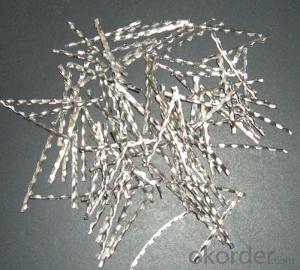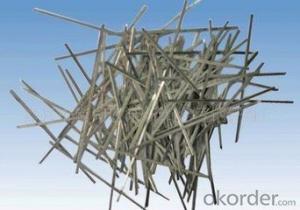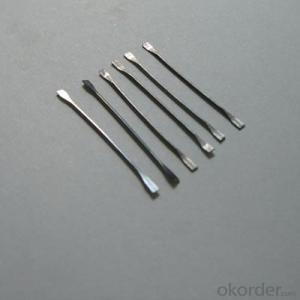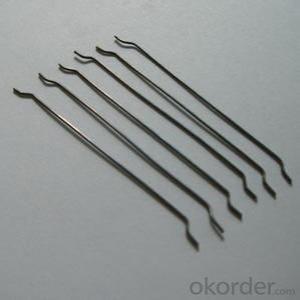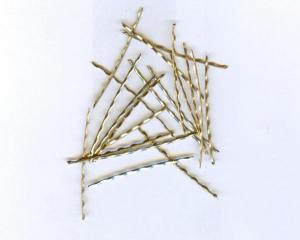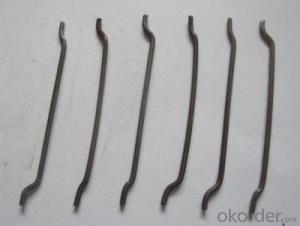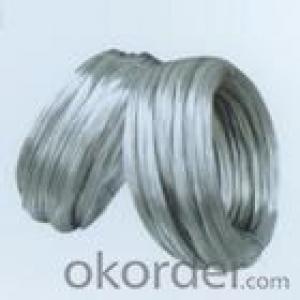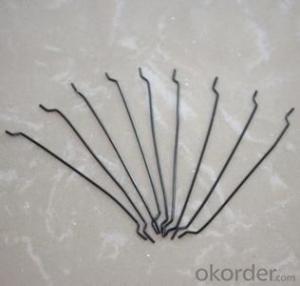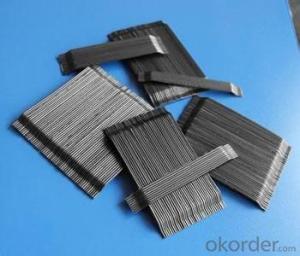Steel Fiber Low Carbon End Hook For Concrete CNBM
- Loading Port:
- Tianjin
- Payment Terms:
- TT or LC
- Min Order Qty:
- 2000 kg
- Supply Capability:
- 250000 kg/month
OKorder Service Pledge
OKorder Financial Service
You Might Also Like
Quick Details
Place of Origin: China (Mainland)
Material: Steel
material: steel wire
application: for concrete reinforcement
appearance: clean and bright
shape: steel fiber
Product features
concrete steel fiber is specifically to enhance concrete in its hardened state ,the uniform distribution of steel fiber throughout the concrete greatly improve concrete bonding and tensile strength ,additionally it provides exceptional load stability and durability ,as reliable and efficient concrete reinforcement material
it is widely ued in buildings ,bridges ,thin roo engineering ,highway etc.
Specifications
length :20-60mm
diameter :0.5MM-1.2MM
tensile strengh:>1100Mpa
diameter | length | tensile strength | |
0.5mm | 35mm | 1100Mpa | |
0.75 | 60mm | 1100Mpa | |
0.9 | 60m | 1100Mpa |
others can do according to your requirement
Picture
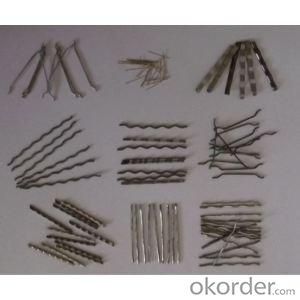
Steel fiber for concrete
concrete steel fiber is specifically to enhance concrete in its hardened state ,the uniform distribution of steel fiber throughout the concrete greatly improve concrete bonding and tensile strength ,additionally it provides exceptional load stability and durability ,as reliable and efficient concrete reinforcement material
it is widely ued in buildings ,bridges ,thin roo engineering ,highway etc.
FAQ
we can produce any type steel fiber and of course we can make production according to your requirement
we have specilize in this field for almost 10 years ,with good quality and competitive price
- Q:How does melt extract stainless steel fiber affect the crack propagation in concrete?
- Crack propagation in concrete is significantly impacted by the presence of melt extract stainless steel fiber. When incorporated into the concrete mix, these fibers serve as reinforcement and enhance the material's mechanical properties. The inclusion of stainless steel fibers in concrete effectively regulates the formation and spread of cracks. These fibers are uniformly dispersed throughout the concrete matrix, creating a three-dimensional network that hinders crack growth. The primary mechanism by which stainless steel fibers affect crack propagation is through crack bridging during the drying and hardening process of concrete. As the concrete undergoes tensile stress and begins to crack, the fibers act as small reinforcements that span across the crack faces. This action effectively transfers the applied load and prevents further crack propagation. This bridging effect enhances the concrete's tensile strength and resistance to cracking. Additionally, stainless steel fibers possess high tensile strength and ductility, offering further advantages in controlling crack propagation. Unlike conventional reinforcement methods like steel rebars, stainless steel fibers can withstand significant deformation without fracturing. This characteristic allows the fibers to absorb and distribute energy over a larger area, reducing stress concentration around the cracks and minimizing their growth. Furthermore, the corrosion-resistant nature of stainless steel fibers ensures long-term durability and performance. Unlike other steel fibers, stainless steel fibers do not corrode in the alkaline environment of concrete, thus maintaining their effectiveness over time. In conclusion, the incorporation of melt extract stainless steel fiber into concrete significantly influences crack propagation by bridging cracks, enhancing tensile strength, absorbing energy, and providing long-term durability. These fibers act as reinforcement, improving the overall performance and lifespan of concrete structures.
- Q:How does melt extract stainless steel fiber improve the fire resistance of shotcrete?
- Melt extract stainless steel fiber improves the fire resistance of shotcrete by providing enhanced structural integrity and heat resistance. The fibers act as reinforcement, reducing cracking and spalling during high temperatures. This helps to maintain the structural stability of the shotcrete, preventing it from collapsing or disintegrating under fire conditions. Additionally, the stainless steel fibers create a barrier that slows down heat transfer, reducing the spread of fire within the shotcrete. Overall, the inclusion of melt extract stainless steel fiber significantly enhances the fire resistance of shotcrete, making it a more reliable and durable material for fire protection applications.
- Q:What is the effect of melt extract stainless steel fiber on the ductility of concrete?
- The ductility of concrete can be positively influenced by adding melt extract stainless steel fiber. Stainless steel fibers are renowned for their high tensile strength and exceptional resistance to corrosion, which can enhance the overall performance of concrete. By incorporating stainless steel fibers into concrete, they serve as reinforcement, imparting additional strength and stability to the material. This reinforcement aids in the even distribution of stress and load throughout the concrete, reducing the likelihood of cracking and increasing its ductility. Concrete infused with melt extract stainless steel fiber exhibits improved flexural strength, toughness, and resistance to impact and fatigue. These fibers create a network within the concrete matrix, effectively bridging cracks and preventing their propagation. This bridging effect heightens the overall ductility of the concrete, enabling it to endure greater deformation and uphold its structural integrity in various loading conditions. Moreover, the corrosion resistance of stainless steel fibers ensures that their mechanical properties endure over time. This long-lasting durability contributes to the sustained ductility of the concrete, even when subjected to harsh environmental conditions or aggressive chemicals. In summary, the addition of melt extract stainless steel fiber to concrete significantly enhances its ductility by providing reinforcement, enhancing crack resistance, and guaranteeing long-term durability. This advancement in ductility enables the concrete to better withstand external forces and maintain its structural integrity, making it a valuable inclusion in construction projects that necessitate high-performance and long-lasting concrete structures.
- Q:Can melt extract stainless steel fiber be used in high-strength concrete?
- Yes, melt extract stainless steel fiber can be used in high-strength concrete. These fibers enhance the strength and durability of the concrete by providing reinforcement and preventing crack propagation. They also improve the resistance to impact, abrasion, and fatigue, making them suitable for high-strength concrete applications.
- Q:Does melt extract stainless steel fiber improve the durability of concrete in marine environments?
- The durability of concrete in marine environments can be improved by melt extract stainless steel fiber. With their resistance to corrosion, stainless steel fibers are perfect for marine environments where concrete is constantly exposed to saltwater and other corrosive elements. These fibers reinforce the concrete, increasing its tensile strength and minimizing cracking, thus safeguarding it from water and salt damage. Moreover, stainless steel fibers boost the overall durability and longevity of concrete structures in marine environments by enhancing their resistance to abrasion and impact. Consequently, the utilization of melt extract stainless steel fibers in concrete can greatly enhance its durability in marine environments.
- Q:Can melt extract stainless steel fiber enhance the resistance of concrete to freeze-thaw cycles?
- The resistance of concrete to freeze-thaw cycles can be enhanced by melt extract stainless steel fiber. Known for their exceptional mechanical properties and durability, stainless steel fibers are an effective reinforcement material for concrete. When incorporated into concrete, these fibers enhance its ability to withstand cracking, spalling, and deterioration caused by freeze-thaw cycles. During freeze-thaw cycles, the water trapped within concrete can expand upon freezing, exerting pressure on the surrounding material. This can result in the formation of cracks and ultimately lead to the degradation of the concrete. However, the inclusion of melt extract stainless steel fibers can help alleviate this problem. The fibers act as reinforcement within the concrete matrix, improving its tensile strength and ductility. This reinforcement assists in evenly distributing the stresses generated by freeze-thaw cycles throughout the concrete, reducing the likelihood of cracking. Additionally, the stainless steel fibers also aid in bridging any cracks that may form, preventing their propagation and minimizing the potential for water penetration. Moreover, stainless steel possesses high resistance to corrosion, which is a common concern in concrete exposed to harsh environmental conditions. By utilizing melt extract stainless steel fibers, the risk of corrosion-induced deterioration can be significantly reduced, ensuring the longevity and durability of the concrete structure. In summary, melt extract stainless steel fiber unquestionably enhances the resistance of concrete to freeze-thaw cycles. Through enhancing the concrete's tensile strength, ductility, crack bridging capability, and corrosion resistance, these fibers contribute to the overall durability and performance of concrete in freezing and thawing conditions.
- Q:How does the size and shape of melt extract stainless steel fiber affect its performance?
- The performance of melt extract stainless steel fiber is greatly influenced by its size and shape in different applications. Firstly, the fiber's surface area and volume are impacted by its size, which in turn affects its bonding strength with other materials. Smaller fibers generally have a larger surface area, allowing for stronger adhesion and better reinforcement of composite materials. Furthermore, the fiber's mechanical properties, such as tensile strength and ductility, are also influenced by its size. Smaller fibers tend to have higher tensile strength and increased flexibility, making them suitable for applications requiring improved structural integrity and resistance to deformation. Additionally, the performance of melt extract stainless steel fiber is dependent on its shape. Fibers with irregular or jagged shapes exhibit enhanced interlocking capabilities, enabling them to provide better mechanical anchorage within the matrix material. This improved interlocking mechanism enhances the fiber's ability to distribute stress and resist crack propagation, thereby increasing the overall durability and toughness of the composite material. On the other hand, fibers with a more regular or smooth shape offer advantages in terms of flowability and dispersibility during the manufacturing process. These fibers tend to exhibit better homogeneity and uniform distribution within the matrix material, resulting in improved mechanical properties and overall performance. In conclusion, the performance of melt extract stainless steel fibers is significantly influenced by their size and shape. Manufacturers can optimize the fiber's bonding strength, mechanical properties, and overall effectiveness in various applications, such as reinforcement in concrete, thermal insulation, or electrical conductivity, by carefully selecting the appropriate size and shape.
- Q:What is melt extract stainless steel fiber?
- Melt extract stainless steel fiber is a type of fiber made from stainless steel through a process called melt extraction. It is used in various industries, including concrete reinforcement, refractories, and composites, to improve the strength, durability, and thermal properties of materials.
- Q:How does melt extract stainless steel fiber improve the impact resistance of concrete pipes?
- Melt extract stainless steel fiber improves the impact resistance of concrete pipes by reinforcing the material and providing additional strength. The fibers act as a reinforcement agent within the concrete matrix, effectively distributing and dissipating the energy from impact forces. This helps to prevent cracks and fractures, enhancing the overall durability and resistance of the concrete pipes to impacts.
- Q:What is the effect of melt extract stainless steel fiber on the modulus of brittleness of concrete?
- The inclusion of melt extract stainless steel fiber has a significant impact on the brittleness modulus of concrete, reducing it greatly. In order to enhance the toughness and ductility of concrete, stainless steel fibers are usually incorporated into concrete mixes. These fibers are dispersed throughout the concrete matrix, acting as reinforcement and promoting a more even distribution of stress. As a result, the concrete becomes more resistant to cracking and exhibits increased flexural strength. Furthermore, the addition of stainless steel fibers aids in the control and limitation of crack propagation within the concrete, effectively decreasing its brittleness. These fibers act as a barrier, preventing cracks from spreading further and thus contributing to the durability and resilience of the material. Ultimately, this improved crack resistance and enhanced ductility contribute to an increase in the brittleness modulus of concrete. Melt extract stainless steel fibers, in particular, are renowned for their exceptional tensile strength and resistance to corrosion. This makes them an ideal choice for reinforcing concrete structures in harsh environments, such as coastal areas or those exposed to chemicals. By incorporating melt extract stainless steel fibers into concrete, the overall performance and longevity of the material are greatly improved. To summarize, the introduction of melt extract stainless steel fibers into concrete results in a significant reduction in its brittleness modulus. This is achieved by enhancing the material's toughness, ductility, and crack resistance. The end result is a concrete that is more durable and resilient, capable of withstanding higher levels of stress and strain without experiencing failure.
1. Manufacturer Overview |
|
|---|---|
| Location | |
| Year Established | |
| Annual Output Value | |
| Main Markets | |
| Company Certifications | |
2. Manufacturer Certificates |
|
|---|---|
| a) Certification Name | |
| Range | |
| Reference | |
| Validity Period | |
3. Manufacturer Capability |
|
|---|---|
| a)Trade Capacity | |
| Nearest Port | |
| Export Percentage | |
| No.of Employees in Trade Department | |
| Language Spoken: | |
| b)Factory Information | |
| Factory Size: | |
| No. of Production Lines | |
| Contract Manufacturing | |
| Product Price Range | |
Send your message to us
Steel Fiber Low Carbon End Hook For Concrete CNBM
- Loading Port:
- Tianjin
- Payment Terms:
- TT or LC
- Min Order Qty:
- 2000 kg
- Supply Capability:
- 250000 kg/month
OKorder Service Pledge
OKorder Financial Service
Similar products
New products
Hot products
Related keywords








